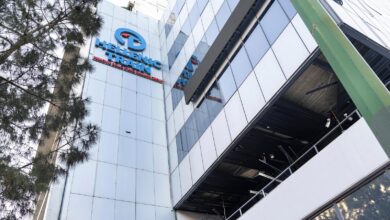Like it or not, the A’s have a new home, and it’s a win for this scrappy city

WEST SACRAMENTO, Calif. — The arrival of a major league team to this decidedly minor league city last week was not, as they say in baseball, error free.
Players for the A’s, formerly of Oakland and eventually to be of Las Vegas, were unfamiliar with the layout of their temporary home, Sutter Health Park. There was “a lot of chaos,” manager Mark Kotsay told the Sacramento Bee, as the team tried to figure out how to navigate the much smaller footprint of a triple-A ballpark.
The Wi-Fi went down. The radio broadcast cut out numerous times. The beer line was epic. The game was paused after someone snuck a drone over the field in the seventh inning. Many die-hard Oakland fans in attendance were still roiled by a sense of betrayal at the manner in which the team departed Oakland. And then there was the score: The A’s lost to the Cubs, 18-3.
Summing it all up, the website SFist pulled no punches with its headline: “A’s first game in Sacramento was a complete debacle, and losing 18-3 was probably the least embarrassing part.”
But for boosters of the unsung city of West Sacramento — a scrappy town of 54,000 that many people, even in the wider region, don’t realize is a city — none of that mattered.
Excitement has been running high ever since team officials announced that the A’s would alight at the 14,000-seat stadium of the minor league River Cats — the triple-A affiliate of the San Francisco Giants — for three years while the A’s future home on the Las Vegas Strip is constructed.
This has been widely described in the national press as a move to the city of Sacramento, California’s capital, which is across the river from West Sacramento and in a different county. Most of the news organizations that crowded in to cover the season opener, and the players they quoted, didn’t seem to register the existence of West Sacramento.
A’s relief pitcher T.J. McFarland’s comments were typical. “It’s a nice city, the state capital,” he told the Sacramento Bee, standing in the heart of West Sacramento’s most treasured civic landmark.
West Sacramento took it all in stride. City officials are used to living in Sacramento’s shadow, and they are confident that bringing the A’s here — even if no one seems to know the team is here — will be a boon.
After all, it’s not the first time that the magic of baseball has lifted this town’s fortunes.
“I couldn’t be happier to share the limelight with our neighbors across the river,” said state Sen. Christopher Cabaldon (D-Yolo), who served two decades as West Sacramento’s mayor before being elected to the Senate last year.
Still, Martha Guerrero, the city’s mayor, made one thing clear: “We prefer West Sacramento. That is the official location.”
West Sacramento has long been the region’s scrawny stepchild of a municipality. The city of Sacramento, population 526,000, with its luminous Capitol dome, graceful tree canopy and Gold Rush-era prominence, was incorporated in 1850. Across the Sacramento River and the county line, the other major towns in Yolo County followed not too long after. Woodland dates to 1871. Winters was incorporated in 1898. And even relative newcomer Davis became an official city in 1917. Woodland was known for its stately Victorian homes; Winters for its picturesque downtown and miles of walnut orchards, velvet green against the purple Vaca Mountains; and Davis for its bustling University of California campus.
But for most of the 20th century, what is now called West Sacramento was a collection of small communities known, in many ways, as a dumping ground for people and pets the city of Sacramento didn’t want.
Back in the day, Sacramento authorities “escorted their criminals, morphine addicts and alcoholics” to the area, according to a historian quoted in the Sacramento Bee in 1984. During Prohibition, the area was known as “Sin City” because it did not embrace the era’s no-alcohol edict. During the Depression, one longtime resident told a local newspaper, it was common practice for Sacramentans to dump dogs and cats they could no longer afford to feed on the West Sacramento side of the river.
By the early 1980s, the area was known as a hub for drugs and prostitution, particularly along a strip of rundown motels that lined West Capital Avenue.
Still, local leaders always had big dreams. In the 1940s, Congress authorized construction of a deep water channel that connected the community with Suisun Bay. In the 1960s, the Port of West Sacramento (originally the Port of Sacramento) became operational, hosting big cargo ships and giving rise to a thriving industrial base.
In the 1980s, developers saw the area’s potential as an affordable bedroom community for legislative aides and other state employees working just a short drive or bike ride away in Sacramento’s downtown, on the other side of the landmark Tower Bridge. Single-family homes started going up on what had been vast acres of cropland sprouting corn, tomatoes, melons and rice.
And in 1987, voters in the area finally voted to incorporate.

The Tower Bridge spans the Sacramento River, connecting West Sacramento with the glittering downtown of its higher-profile neighbor, the city of Sacramento.
(Christina House / Los Angeles Times)
It was shortly after this that Cabaldon moved to town.
“I accidentally ended up in West Sacramento,” he said. The year was 1993, and he was starting work as a legislative staffer. A real estate agent took him to a “great neighborhood” that was “unusually affordable” and promised that exciting shops, restaurants, parks and other amenities were coming soon. Cabaldon was sold. “I didn’t realize it was the other side of the tracks, and no one wanted to go there at night,” he said.
Cabaldon grew to love his little city. He admired its gorgeous riverfront — mostly underused land, but so much potential. Still, he noticed that many of the amenities the real estate agent had promised were nowhere on the horizon. And he gathered, too, that the city had long felt like an underdog.
Instead of moving, he ran for City Council. He lost, but ran again and won in 1996. By 1998, he was mayor. Shortly thereafter, he recalled, he was approached by developers who wanted to build a minor league ballpark in the city.
“We kind of ran with it,” he said. “It really changed the notion that we were the armpit of the region.”
The park was built, and by 2001, the River Cats had moved in (originally as a farm team for the Oakland A’s before becoming the Giants’ triple-A affiliate in 2015). The ballpark, which is a stone’s throw from the Sacramento River and about a mile from the Capitol, quickly became a draw for people across the region.
Sure, the team took the name the Sacramento River Cats, but their presence in West Sacramento helped spur a whole new wave of development: affordable condos, apartments and townhomes geared toward young workers and, finally, the long-promised restaurants and big-box stores so that all these new residents had places to eat and shop without crossing the river. Parcel by parcel, the land along the city’s waterfront was transformed into entertainment venues, parks and trails.
“We’ve done so many ribbon cuttings,” said Guerrero, the mayor.
West Sacramento was on its way, even before the A’s very bad breakup with Oakland.
The Oakland Coliseum, the A’s longtime home, was widely considered one of the most run-down stadiums in the major leagues — baseball’s last dive bar, as the Guardian newspaper put it. There were, famously, feral cats roaming the complex. Dead mice where they didn’t belong. Sewage issues. Barbed wire. And so much concrete.
“It’s a giant concrete toilet bowl,” said baseball analyst Eric Byrnes, who played six seasons for the A’s. “But it’s their toilet bowl, and it’s a special toilet bowl.”
The A’s owner, John Fisher, made no secret of his desire to get out, and when he finally did, hatching a plan to move to a $1.5-billion stadium on the Las Vegas Strip, residents of Oakland — and a host of nostalgic sportswriters — erupted with fury and heartbreak.

In a 2023 photo, fans at Oakland Coliseum protest the A’s plans to relocate.
(Jed Jacobsohn / Associated Press)
“The argument could be made that the A’s departure from their run-down home for the riches of Las Vegas is a large part of what’s wrong with American professional sports today,” the New York Times said.
“The Oakland A’s were so much to so many of us, for so long, and now they are nothing at all,” wrote Ellen Cushing in the Atlantic.
At the last game in the Coliseum, desperate fans assailed the owner with loud chants of “Sell the Team.” Then they waited in line to collect dirt from the old diamond.
It is said there are two sides to every breakup. But in this divorce, it seemed almost everyone took the side of Oakland and its fans.

The A’s season opener in West Sacramento was marked by operational glitches as the team figured out how to navigate the much smaller footprint of a triple-A ballpark.
(Scott Marshall / Associated Press)
All these months later, West Sacramento officials emphasize they played no part in stealing the team from Oakland. But they also don’t hide their pride in being the A’s rebound city — even if it’s just for three years.
They spent the off-season making upgrades to the stadium, including a new clubhouse and expanded locker room facilities. They came up with a parking plan to accommodate what are expected to be bigger crowds. They added premium seating.
The dream, Guerrero said, is that the A’s short-term relationship with West Sacramento is such a success that Major League Baseball considers the region for an expansion team. And all the dreamier if they put that team in her town — and not that stepsister city across the river.
“West Sacramento has a strong fan base,” Guerrero said. “We’re a baseball city.”
https://ca-times.brightspotcdn.com/dims4/default/9298b92/2147483647/strip/true/crop/5697×2991+0+404/resize/1200×630!/quality/75/?url=https%3A%2F%2Fcalifornia-times-brightspot.s3.amazonaws.com%2F58%2F4e%2Fba59b5a943a3bd997ec772a5623f%2Fcubs-athletics-baseball-09565.jpg
2025-04-08 05:00:49




